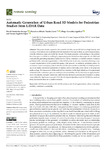Automatic Generation of Urban Road 3D Models for Pedestrian Studies From LiDAR Data

Ver/
Use este enlace para citar
http://hdl.handle.net/2183/30295
A non ser que se indique outra cousa, a licenza do ítem descríbese como Atribución 4.0 Internacional
Coleccións
- Investigación (ETSECCP) [826]
Metadatos
Mostrar o rexistro completo do ítemTítulo
Automatic Generation of Urban Road 3D Models for Pedestrian Studies From LiDAR DataAutor(es)
Data
2022Cita bibliográfica
Fernández-Arango, D.; Varela-García, F.-A.; González-Aguilera, D.; Lagüela-López, S. Automatic Generation of Urban Road 3D Models for Pedestrian Studies from LiDAR Data. Remote Sens. 2022, 14, 1102. https://doi.org/10.3390/rs14051102
Resumo
[Abstract] The point clouds acquired with a mobile LiDAR scanner (MLS) have high density and accuracy, which allows one to identify different elements of the road in them, as can be found in many scientific references, especially in the last decade. This study presents a methodology to characterize the urban space available for walking, by segmenting point clouds from data acquired with MLS and automatically generating impedance surfaces to be used in pedestrian accessibility studies. Common problems in the automatic segmentation of the LiDAR point cloud were corrected, achieving a very accurate segmentation of the points belonging to the ground. In addition, problems caused by occlusions caused mainly by parked vehicles and that prevent the availability of LiDAR points in spaces normally intended for pedestrian circulation, such as sidewalks, were solved in the proposed methodology. The innovation of this method lies, therefore, in the high definition of the generated 3D model of the pedestrian space to model pedestrian mobility, which allowed us to apply it in the search for shorter and safer pedestrian paths between the homes and schools of students in urban areas within the Big-Geomove project. Both the developed algorithms and the LiDAR data used are freely licensed for their use in further research.
Palabras chave
LiDAR point cloud
Mobile LiDAR system
Point cloud segmentation
Urban road
Urban mobility
Pedestrian accessibility
Mobile LiDAR system
Point cloud segmentation
Urban road
Urban mobility
Pedestrian accessibility
Versión do editor
Dereitos
Atribución 4.0 Internacional






